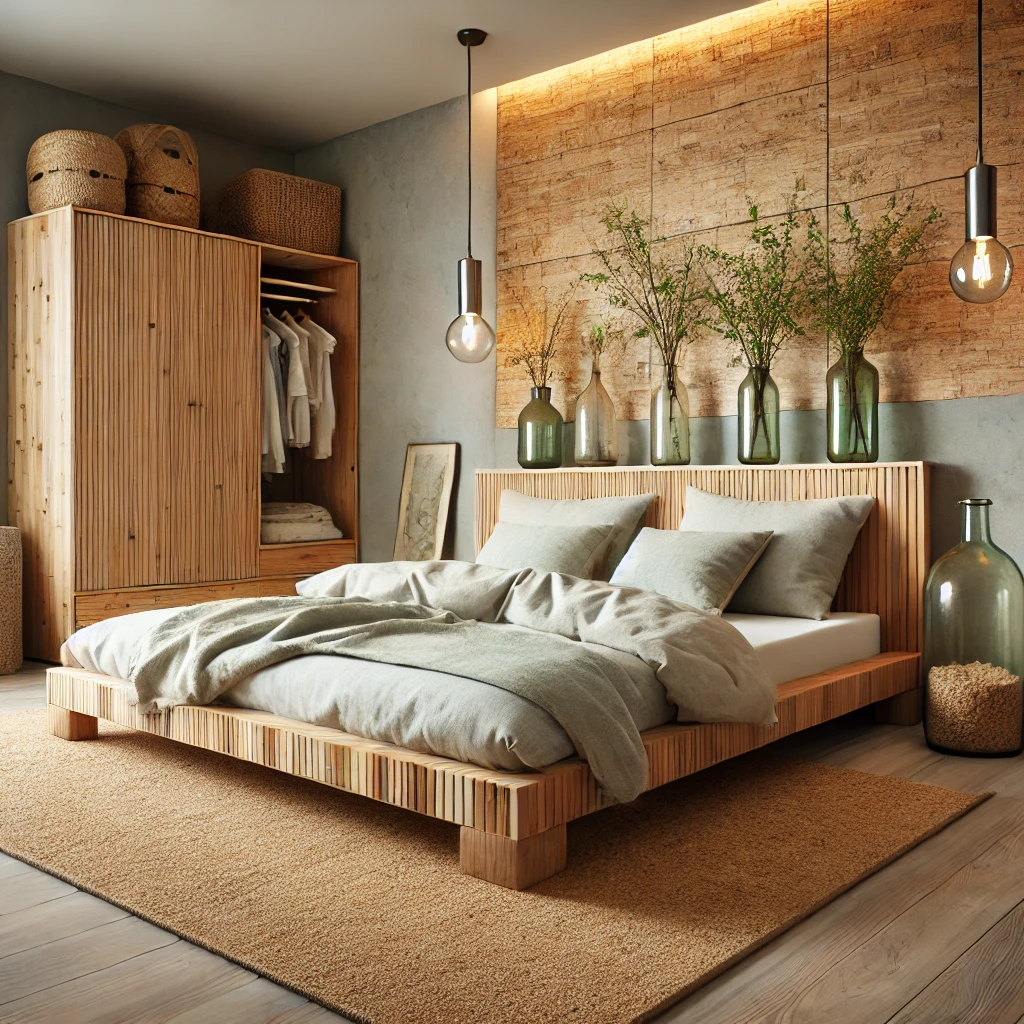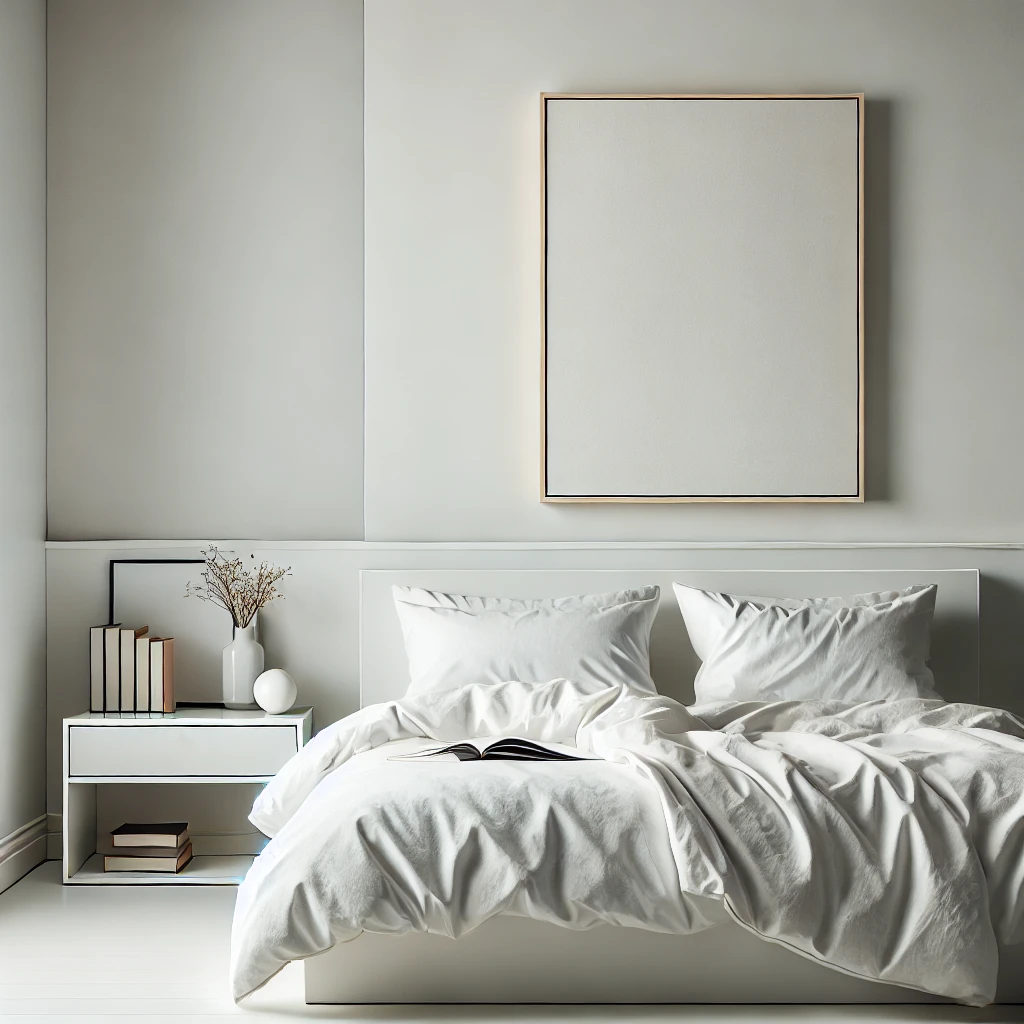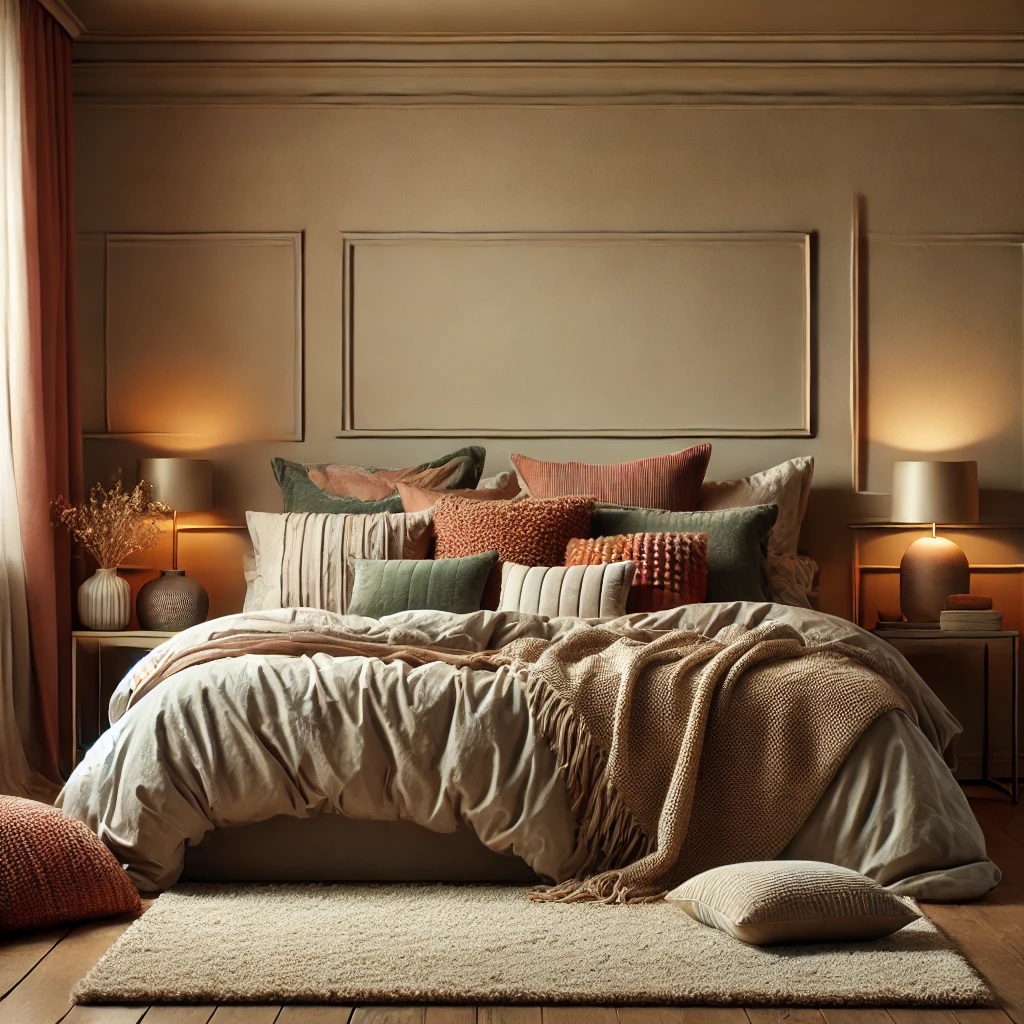Introduction
The bedroom is more than just a place to rest—it’s a personal sanctuary where we begin and end our days. As we navigate through 2025, interior design trends are evolving to reflect our changing lifestyles, values, and aesthetic preferences. This year, the focus is on creating spaces that are not only visually appealing but also promote well-being, sustainability, and personal expression. From incorporating natural elements to embracing smart technology, here are the top bedroom design trends that are shaping the way we think about our most intimate spaces.
1. Biophilic Design: Bringing Nature Indoors

Embracing the Natural World
Biophilic design is all about forging a deeper connection with nature within our indoor environments. This trend emphasizes the use of natural materials, abundant greenery, and organic shapes to create a calming and rejuvenating atmosphere.
Key Elements:
- Indoor Plants: Incorporate a variety of houseplants, such as snake plants, peace lilies, or hanging ferns, to purify the air and add a touch of greenery.
- Natural Light: Maximize natural light by using sheer curtains or opting for larger windows to create a bright and airy space.
- Organic Materials: Utilize wood, stone, and natural fibers in furniture and decor to bring earthy textures into the room.
- Nature-Inspired Colors: Choose color palettes that reflect the outdoors, such as soft greens, blues, and earthy browns.
Why It Works:
Biophilic design has been shown to reduce stress, enhance creativity, and improve overall well-being. By integrating natural elements, your bedroom becomes a serene retreat that nurtures both mind and body.

2. Warm Neutrals and Earth Tones: Creating Cozy Sanctuaries
The Shift Towards Comfort
After years of cool grays dominating interior design, there’s a shift towards warmer neutrals and earth tones. These colors evoke feelings of warmth, comfort, and relaxation—perfect for a bedroom setting.
Key Elements:
- Color Palette: Incorporate shades like beige, taupe, terracotta, soft greens, and muted yellows.
- Textiles: Use cozy fabrics like linen, wool, and cotton in bedding, curtains, and rugs to enhance the warmth.
- Accent Pieces: Add throw pillows, blankets, and artwork that complement the earthy tones.
Why It Works:
Warm neutrals and earth tones create an inviting and restful environment. They are versatile and can be easily paired with various styles and decor elements, allowing for personal expression while maintaining a cohesive look.
3. Minimalism with Personal Touches: The Balance of Simplicity and Identity
Decluttered Spaces with Character
Minimalism continues to be a popular design approach, focusing on simplicity and functionality. However, the 2023 twist involves adding personal touches that reflect individual style without cluttering the space.
Key Elements:
- Functional Furniture: Opt for pieces with clean lines and hidden storage to keep the room tidy.
- Personal Decor: Display meaningful items like travel souvenirs, family photos, or artwork to add personality.
- Neutral Base: Start with a neutral color scheme and layer in textures and accents that showcase your taste.
Why It Works:
This trend offers the best of both worlds—the serenity of a minimalist space and the warmth of personal expression. It encourages mindful consumption and promotes a clutter-free environment conducive to relaxation.

4. Sustainable and Eco-Friendly Materials: Designing with a Conscience
Eco-Chic Living
Sustainability is more than a buzzword; it’s a lifestyle choice that’s influencing interior design. Using eco-friendly materials not only benefits the environment but also adds unique character to your bedroom.
Key Elements:
- Sustainable Furniture: Choose pieces made from bamboo, reclaimed wood, or recycled materials.
- Organic Textiles: Opt for bedding and curtains made from organic cotton, linen, or hemp.
- Low-VOC Paints: Use paints and finishes that have low levels of volatile organic compounds to improve indoor air quality.
- Upcycled Decor: Repurpose vintage items or DIY projects to reduce waste and add charm.
Why It Works:
Designing sustainably fosters a sense of responsibility and connection to the world around us. Eco-friendly materials often have a timeless appeal, ensuring your bedroom remains stylish for years to come.
5. Textured Walls and Ceilings: Adding Depth and Character
Beyond Flat Surfaces
Textures are making a big comeback in interior design, particularly on walls and ceilings. Adding texture creates visual interest and depth, transforming plain surfaces into focal points.
Key Elements:
- Textured Paint: Use specialized paints that create effects like suede, metallic, or sand textures.
- Wallpaper: Choose wallpapers with embossed patterns or natural textures like grasscloth.
- Wood Paneling: Install shiplap, beadboard, or reclaimed wood panels for a rustic or coastal vibe.
- Ceiling Treatments: Consider coffered ceilings, exposed beams, or decorative tiles to elevate the space.
Why It Works:
Textured walls and ceilings break the monotony of flat surfaces and can highlight architectural features. They add a layer of sophistication and make the room feel more dynamic and engaging.
6. Statement Headboards: The Bedroom’s Focal Point
The headboard is no longer just a functional piece; it’s a statement of style. Oversized and uniquely designed headboards are becoming the centerpiece of bedroom decor.
Key Elements:
- Grand Scale: Opt for tall or wide headboards that draw the eye and anchor the bed within the room.
- Unique Materials: Consider upholstered headboards with rich fabrics, tufted designs, or intricate carvings.
- Custom Designs: Personalize your headboard with DIY projects or bespoke creations that reflect your taste.
Why It Works:
A statement headboard adds drama and personality to the bedroom. It can set the tone for the entire design scheme and offers an opportunity to showcase creativity.

7. Smart Technology Integration: The Future of Comfort
Modern Convenience Meets Style
As technology advances, integrating smart devices into the bedroom enhances comfort and efficiency without compromising aesthetics.
Key Elements:
- Smart Lighting: Install programmable lights that adjust brightness and color temperature according to the time of day or mood.
- Automated Blinds: Use motorized window treatments that can be controlled remotely or set on schedules.
- Climate Control: Incorporate smart thermostats that learn your preferences and optimize energy use.
- Voice Control: Enable voice-activated assistants to control various devices hands-free.
Why It Works:
Smart technology simplifies daily routines and creates a personalized environment. It can also contribute to energy savings and improve the overall functionality of the bedroom.
8. Layered Lighting: Crafting the Perfect Ambiance
Illuminating with Intention
Lighting is a crucial element in bedroom design, affecting both functionality and mood. Layered lighting combines different types of fixtures to create a versatile and inviting space.
Key Elements:
- Ambient Lighting: Provide general illumination with ceiling fixtures or recessed lights.
- Task Lighting: Use bedside lamps, reading lights, or desk lamps for specific activities.
- Accent Lighting: Highlight artwork, architectural features, or decor with spotlights or LED strips.
- Dimmers and Controls: Install dimmer switches and smart controls to adjust lighting levels easily.
Why It Works:
Layered lighting allows you to customize the ambiance for various activities, from reading to relaxing. It enhances the room’s aesthetics and improves its functionality.
9. Mixed Metals and Materials: Sophisticated Blending
The Art of Contrast
Mixing metals and materials adds depth and visual interest to the bedroom. This trend encourages experimentation with different finishes and textures to create a curated look.
Key Elements:
- Metal Finishes: Combine brass, copper, chrome, and brushed nickel in fixtures, hardware, and decor.
- Material Variety: Mix wood, glass, marble, and textiles to create contrast and balance.
- Consistency: Maintain cohesion by choosing metals and materials that complement each other in color and style.
Why It Works:
Blending different metals and materials adds richness to the design. It prevents the space from feeling too matchy-matchy and showcases a sophisticated understanding of design principles.
10. Artisanal and Handmade Decor: Celebrating Craftsmanship
Unique Pieces with Stories

There’s a growing appreciation for artisanal and handmade items that bring authenticity and character to the bedroom.
Key Elements:
- Textiles: Incorporate handwoven rugs, embroidered pillows, or knitted throws.
- Wall Art: Display original paintings, prints, or macramé wall hangings.
- Ceramics and Pottery: Use handcrafted vases, bowls, or decorative objects.
- Custom Furniture: Invest in bespoke pieces crafted by local artisans.
Why It Works:
Handmade decor adds a personal touch and supports artisans and small businesses. These pieces often have unique qualities and stories that enrich the space.
11. Multi-Functional Furniture: Maximizing Space and Utility
Smart Solutions for Modern Living
As living spaces become more compact, multi-functional furniture is essential for maximizing space without sacrificing style.
Key Elements:
- Storage Beds: Choose beds with built-in drawers or lift-up platforms for extra storage.
- Convertible Furniture: Use desks that transform into vanities or seating with hidden compartments.
- Modular Pieces: Opt for furniture that can be reconfigured to suit different needs.
Why It Works:
Multi-functional furniture enhances the practicality of the bedroom, making it adaptable to various activities and needs. It’s especially beneficial in smaller spaces where every square foot counts.
12. Vintage and Retro Accents: Nostalgia Meets Modernity
Blending the Old with the New
Incorporating vintage or retro elements adds charm and uniqueness to the bedroom. This trend is about mixing classic pieces with contemporary design for a timeless appeal.
Key Elements:
- Antique Furniture: Include vintage dressers, side tables, or mirrors.
- Retro Lighting: Use mid-century modern lamps or chandeliers.
- Decorative Accents: Add vintage clocks, radios, or artwork.
- Pattern Play: Incorporate retro patterns in wallpapers, fabrics, or rugs.
Why It Works:
Vintage and retro accents bring character and a sense of history to the bedroom. They can serve as conversation pieces and create a layered, eclectic look.
Conclusion
The bedroom is a personal haven that reflects our innermost desires and lifestyles. The 2023 interior design trends emphasize comfort, sustainability, personalization, and technological integration. Whether you’re drawn to the serenity of biophilic design, the warmth of earth tones, or the sophistication of mixed metals, there’s a trend that resonates with every style.
Remember, the best design is one that makes you feel at ease and authentically represents who you are. Don’t be afraid to mix and match trends, experiment with new ideas, and most importantly, create a space where you love to start and end your day.
Final Thoughts
Updating your bedroom doesn’t have to be an overwhelming task. Start by identifying the elements that matter most to you and gradually incorporate them into your space. Whether it’s adding a few indoor plants, investing in a statement headboard, or integrating smart technology, small changes can make a significant impact.
Stay true to your personal style, prioritize comfort and functionality, and embrace the trends that enhance your well-being. After all, your bedroom is more than just a room—it’s your personal sanctuary.
